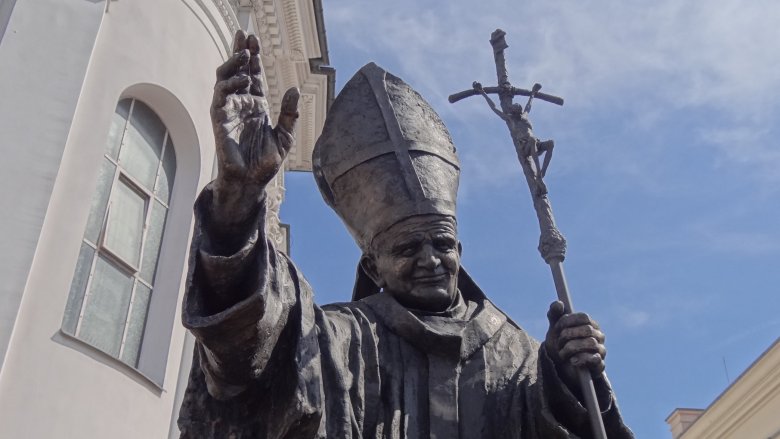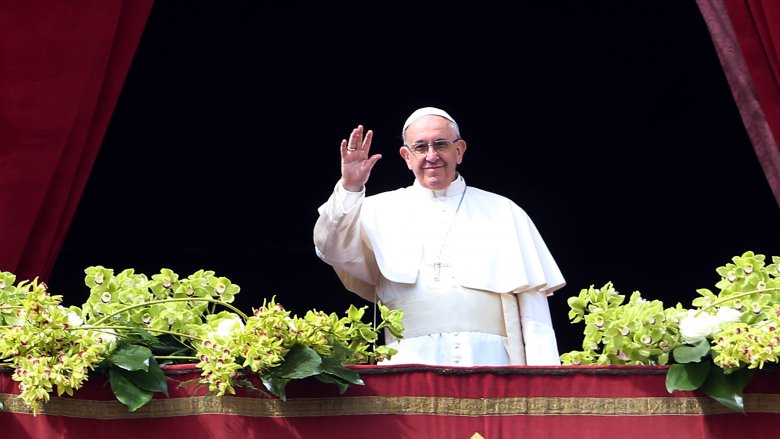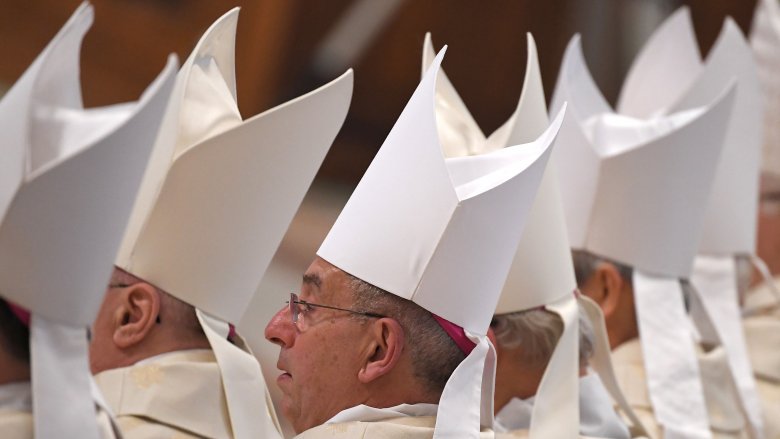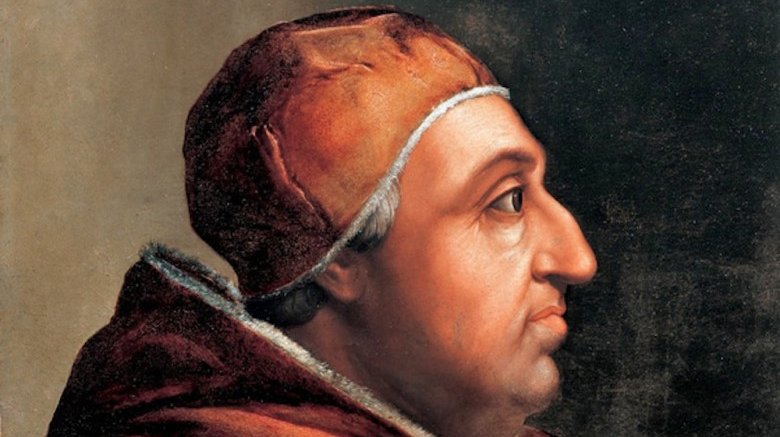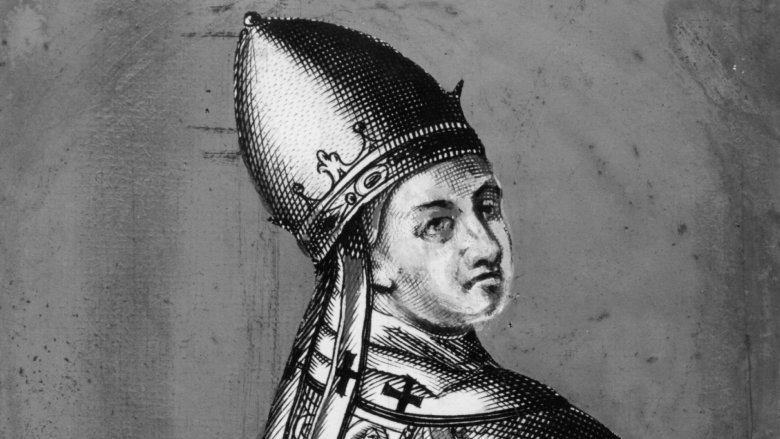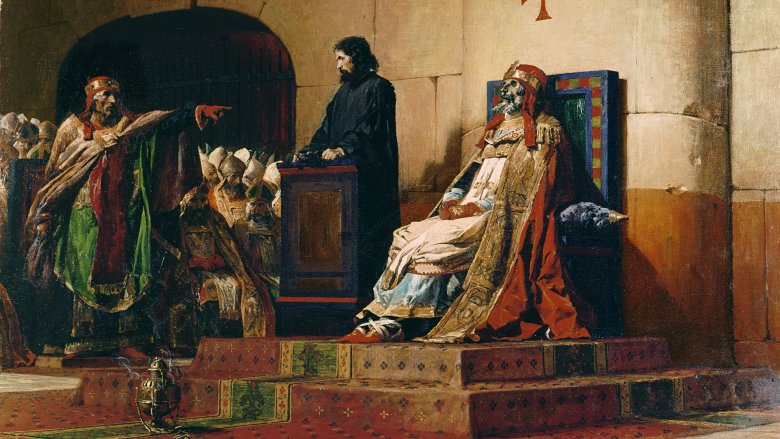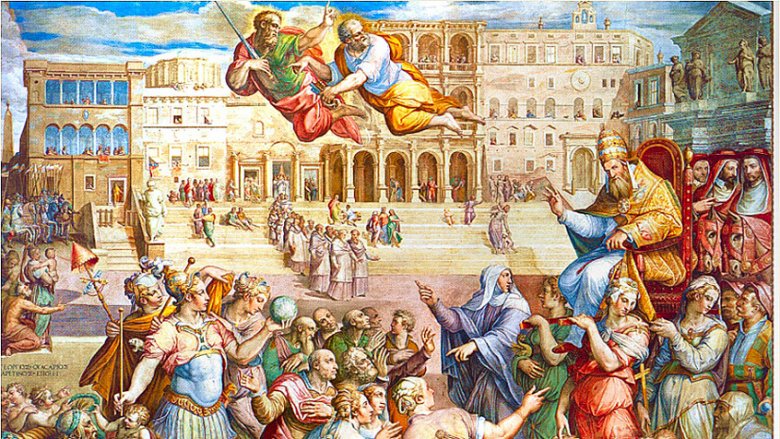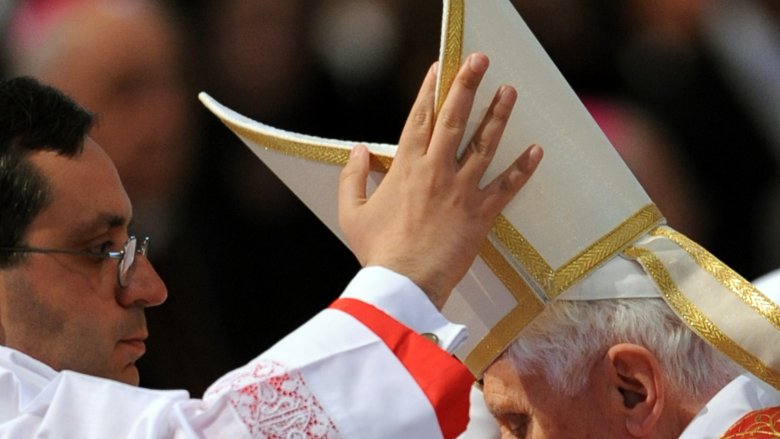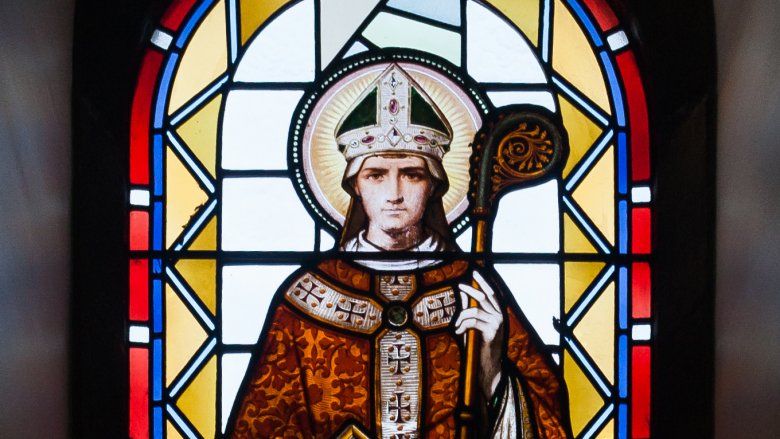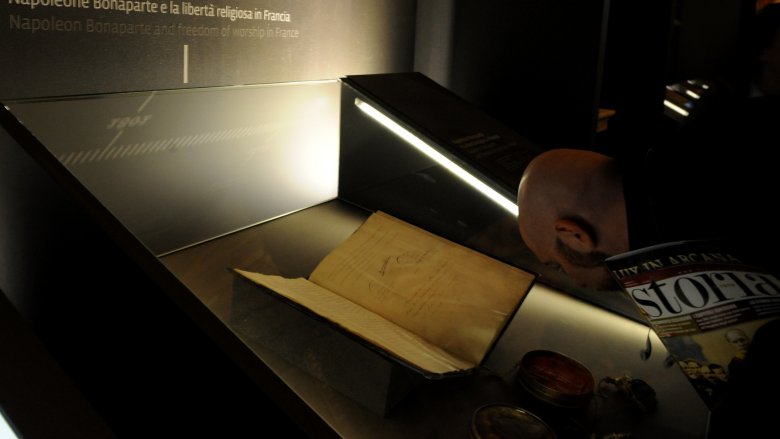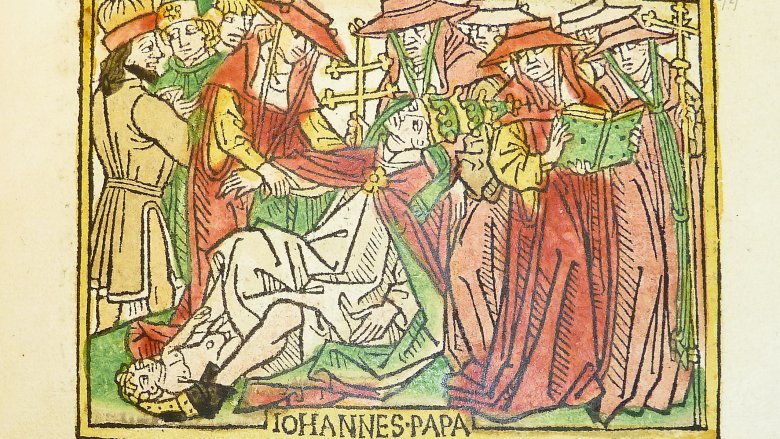Myths About The Pope You Probably Believe
We may receive a commission on purchases made from links.
The pope! The supreme pontiff! The Bishop of Rome! @Pontifex! He is all these things and more. The pope is the head of the worldwide Catholic Church, the largest Christian denomination in the world, and one of history's oldest religious institutions, claiming a connection by apostolic succession all the way back to Saint Peter, the one from Sunday school and the Bible.
By virtue of its being such a long-standing and prestigious position, a number of legends, myths, and misconceptions have arisen surrounding the papacy, both positive and negative. On the one hand, there are those who place so much stock in the historical and spiritual significance of the pope's position that they hold him to a higher standard than might be possible for a human being. On the other hand, there is no shortage of conspiracy theories surrounding the pope and the Vatican as a whole that are spread by Chick tracts and such.
While it's unlikely that you believe both that the pope is incapable of sin and that his hat is secretly broadcasting a code letting you know he is the literal Beast of the Apocalypse, there is a chance that somewhere in this list you'll find a misconception that you hold about the good old pontifex maximus.
The pope is infallible
One of the most widely believed and also most widely misunderstood papal properties is the idea of the pope being infallible. What many people, both inside and outside the Catholic Church, often interpret this to mean is that the pope never makes mistakes and, indeed, never sins. While it is true that papal infallibility is a thing, it doesn't mean that the pope never does a cuss if he hits his funny bone on a crozier or something, nor that he could win any spelling bee without hesitation.
According to Catholic Answers, papal infallibility means the pope cannot speak in error only in the cases in which he is speaking in an official capacity about a doctrine of faith or morals that is meant to pertain to the whole Church. And what's more, the pope isn't the only one this applies to: In fact, every bishop has infallibility as long as he is teaching in unity of belief with the pope . (This might seem obvious — that if Person A is right and Person B agrees with them, Person B is also right — but, look, sometimes you gotta lay stuff out.)
So, while it's true that there are circumstances in which the pope is infallible, it's only under certain pretty specific conditions, which means that it's not likely that he'll publish a decree called "Jesus Was a Ferret, Actually," but if he does, we know it has to be true.
The pope is a special kind of Holy Order
The Catholic Church recognizes and celebrates seven sacraments: baptism, confirmation, eucharist, penance, matrimony, anointing of the sick (formerly known as extreme unction, which sounds like the grossest possible Mountain Dew flavor), and holy orders. Holy orders is what is known as a "sacrament of service," and it is basically the process by which someone is ordained into the service of the Church. It is thus pretty reasonable to assume that the pope is the coolest, biggest, most enviable Holy Order of them all.
However, as Loyola Press explains, there are only "three levels of participation in the Sacrament of Holy Orders": bishop, priest, and deacon. A bishop is an overseer and head of a local area known as a diocese; a priest serve smaller communities, usually an individual church; and a deacon assists a priest or bishop in administrative or other duties. So other offices you might hear of, like archbishops or cardinals, are also not their own holy orders, they're just higher-ranking (or otherwise distinct) bishops or priests.
The pope, then, is not his own special class completely apart from everyone else. He's just the biggest, beefiest bishop there is (in a spiritual sense). Indeed, his official title is the Bishop of Rome, and his diocese is, well, Rome, also known as the Holy See, which sounds like a nonsense phrase unless you know "see" means "seat" and refers to his fancy bishop chair as a metaphor for his seat of influence.
The pope is always celibate
Among Catholic clergy, the practice of celibacy, i.e., the voluntary decision never to get married or become sexually active, goes back centuries, possibly as far back as the fourth century C.E., with it becoming a requirement by the late Middle Ages. The idea is celibacy helps a clergyman's earthly life reflect life in Heaven, helping provide a detachment from corporeal pleasure and an allowing his attention to be undividedly toward the Lord. Cool, cool.
Anyway, priests and bishops — and by extension the pope – are supposed to be celibate. And while we can take most popes at their word that they deffo for real behaved forever, there is enough evidence of popes who didn't that it necessitates one of the best Wikipedia pages ever: "List of sexually active popes."
Just as one example, Live Science tells of Pope Julius II, who had multiple mistresses and at least one illegitimate child, to the point that a council alleged he was "a sodomite covered with shameful ulcers." Likewise, Alexander VI had several mistresses and sired between seven and ten illegitimate children, most of them with his mistress Vannozza dei Cattanei. In fact, you might have heard of them. The Borgias? There was a TV show about them.
You are, naturally, wondering, were there any who were active in, like, a gay way? Yes, of course there were, including Sixtus IV — after whom the Sistine Chapel is named — who was known as a "lover of boys and sodomites," trading church positions for sexual favors.
The pope is by necessity the holiest person alive
As the head of one of the largest, oldest, most prestigious religious institutions in history, it would be very easy to assume that the pope made his way to the top by being the holiest dude alive at any given time. And again, assuming in good faith that many or even most popes have in fact been pretty good boys, there is a pretty squirrely period of history in which it seems like each successive pope was trying to out-evil the previous one. (This period of history is known as "the Middle Ages and then even some of the Early Modern Era.")
In a Time magazine article that they pretty generously call "Top 10 Controversial Popes," we get a couple examples of some not-so-pious pontiffs. You've got Boniface VIII, who was basically a dictator who believed "every human creature [was] subject to the Roman pontiff" and who hired mercenaries to wreck other people's stuff. Clement V took bribes, levied oppressive taxes, pitted countries against each other, and is one of the popes Dante placed in Hell. Sergius III put out a hit on another pope and then had an illegitimate son who himself later went on to become pope. Then you've got Benedict IX, who was described by another pope as having "life as a pope so vile, so foul, so execrable, that I shudder to think of it" and who straight up sold the papacy, presumably putting up the double birds as he strutted out of the Vatican with his fat simony stacks.
The pope would definitely not, for example, desecrate a grave for petty reasons
There's bad, and then there's bad. Lots of popes violated their vows of celibacy or accepted bribes or engaged in nepotism or enjoyed a little light despotism every now and then. Those things happened so often that acceptable papal behaviors shifted to the degree that, for example, putting out a hit on a rival pope seems pretty quaint. Then there's Stephen VI.
As summarized by Atlas Obscura, in an event known as the Cadaver Synod or the Synodus Horrendus (literally "The council to make your flesh crawl"), Stephen VI put his predecessor (but not his immediate predecessor; there was a guy who was pope for 15 days before his foot hurt so bad that he died or maybe Stephen VI murdered him) Formosus on trial for trumped up charges of perjury and going to Bulgaria. This was a totally normal trial and there was nothing out of the ordinary except that the defendant was completely raggedy skeleton bones dressed in pope clothes when they put him on trial.
So in 897, Pope Stephen VI successfully prosecuted a corpse with a number of crimes and stripped him of his pope clothes, cut off his blessing fingers, and officially declared everything he did as pope to be Officially Total Garbo. Then he threw his body in a foreigner's grave, only to dig it back up, tie it down with weights and throw it into the Tiber River. Don't worry, though: When word of this got out, a mob threw Stephen in jail where he was strangled to death.
There's only ever one pope at a time
There's only one pope, right? One Bishop of Rome, one Holy See, one invisible car. Except sometimes you also get antipopes. What are antipopes? Well, hailing from an antimatter universe and composed of analogous particles with charges opposite to those commonly found in popes–positrons, antiprotons, etc., antipopes are — wait, sorry. Antipopes are actually religious figures who oppose the standing pope by making a competing claim to being the legitimate pope, usually with significant support from various cardinals and followers. It's like if after the 2000 election, Al Gore never conceded and called himself president and he lived in, like, Washington state in a place called the Green House and half of the country accepted him as the real president. Except this happened dozens of times between the 3rd and 15th centuries.
Antipopes were most frequent was during the 11th and 12th centuries, when there were significant struggles for power between various popes and various Holy Roman Emperors. The emperors would put forth their own candidate for pope, who would be someone who would support and further the emperor's causes, up against whoever was actually elected by the cardinals. And in basically the super baller-est move of all time, the pope would respond to the emperor by themselves setting up an anti-king, which sounds made up but which actually happened at least a dozen times between the 10th and 15th centuries.
The Western Schism between 1378 and 1417 meant a second pope set up shop in Avignon, France, and there were two popes all the time. Except when there were three.
The pope's hat secretly tells you he's the Antichrist
There is no shortage of conspiracy theories about the pope. The supreme pontiff is especially un-pope-ular (self-high five) with certain Protestant sects who argue he is the literal Beast of the Apocalypse and/or Antichrist. One piece of "evidence" to support this claim is that the pope's cool hat says "VICARIVS FILII DEI" ("vicar of the Son of God") on the side of it, and if you pull out the letters from that phrase that are also Roman numerals, they add up to 666.
However, as pointed out in an Envoy Magazine article by Patrick Madrid that was later expanded into a book called Pope Fiction, "Vicarius Filii Dei" is not one of the titles of the pope. He is, however, called Vicarius Christi ("the vicar of Christ"), but by the same reckoning, this phrase only adds up to 214, which is not even in the Neighborhood of the Beast. None of his other official Latin titles add up to the dreaded 666 either. Even worse for this theory is the fact that the papal tiara (the fancy hat that this particular rumor is about, not his normal fancy hat) does not now nor has it ever had any writing on it at all, let alone a secret Antichrist code.
One nice stinger pointed out by Madrid is that the same Roman numeral method will produce 666 when you run it on the name of Ellen Gould White, the founder of the Seventh-Day Adventist Church, a group that particularly distrusts the pope.
A list of popes tells us that the end of the world is coming soon
In 2013, when the papal conclave began, with 115 cardinals gathering to elect a successor to the recently retired Benedict XVI, some might have wondered why they were bothering, as they've known who the next pope would be since 1595, and in fact that the next pope would actually be the last pope. Ever.
They knew this because it was published in 1595 as part of a book called Lignum Vitae, a history of the Benedictine Order of monks. The relevant portion is called The Prophecy of the Archbishop Saint Malachy About the Popes, commonly known as the Prophecy of the Popes.
This work is a list of mysterious Latin phrases that purport to predict the popes from Saint Malachy's time in the 12th century until, literally, kingdom come, which, as it happens, are accurate if cryptic descriptions of the popes up until the time this work was "discovered" in 1590 and then basically not accurate at all with a few exceptions for the centuries after that. Strange how that happens.
For example, the first phrase listed is "from a castle on the Tiber," which lines up with Pope Celestine II. Why? The reason given is "He comes from Tifernum," which was a city on the Tiber. Wow, magical.
Anyway, according to the prophecy, the current pope is the last one, who will oversee the end of the world. However, his name is supposed to be Peter the Roman and not Francis the Argentine, and then you can basically choose your own debunking adventure after that.
The pope has documents written by Jesus or aliens or something hidden in the Vatican
The Vatican contains a collection of documents known as the Vatican Secret Archives that were founded in 1612 and which were fully closed to the public until 1881, and even then they were only open to Catholic scholars for study. Many have speculated on the contents of these secret archives, asserting that they contain evidence of aliens or demons or copies of the classic '90s Sinbad vehicle Shazaam. Some even claim that the Vatican Archives contain documents actually written by Jesus himself, or that pertain directly to him, such as the execution order written by Pontius Pilate.
However, as Mental Floss points out, the name "Secret Archives" is actually a mistranslation of something that would be better translated as "private archives." The contents were never meant to be secret; they're simply the personal documents of past popes. In 2012, the Vatican made 100 documents from the archives available for the public to view, including the proclamation that excommunicated Martin Luther, transcripts from the trials of the Knights Templar, a letter to Pius IX from Abraham Lincoln, the official declaration of the doctrine of the Immaculate Conception, and letters concerning the trial of Galileo. The closest thing to evidence of UFOs is a design by an 18th-century Brazilian priest of a flying machine that looks like a bird-shaped bouncy castle.
Apparently if you want to find the really good stuff, you have to find a way to sneak into the Vatican Double Secret Archives.
There was a woman pope
Pope John VIII was elected pope after the death of Leo IV, due to the great respect he had engendered as a teacher and scholar in Athens. But this was all a trick of the devil, as John was really a Joan! She had traveled to Athens as a young woman with her lover, who suggested that she disguise herself as a young man for some reason.
Anyway, through an escalating series of dares, young Joan found herself elected the pope in Rome, and everything was pretty cool until she got pregnant and then totally had a baby in the middle of the road while everyone was watching. You know this was bad news because it rained blood for three days and nights in northern Italy.
All the people who witnessed this birth grabbed the pope, tied her feet to a horse, and she was dragged for a mile and a half to her death. They buried her where she died and marked the place "Petre, Pater Patrum, Patrisse Prodito Partum," which means, "Peter, Father of Fathers, Betray the Childbirth of the Popess." As a result, all newly elected popes in the Middle Ages had to sit in a special chair with a hole in the seat, after which a cardinal would reach his hand up and feel around a little, then hopefully proclaim, "Duos habet et bene pendentes," which means, "He has two, and they hang nicely."
Anyway, as the Catholic Encyclopedia points out, none of that happened, right up to and including the testicle test.
